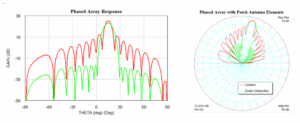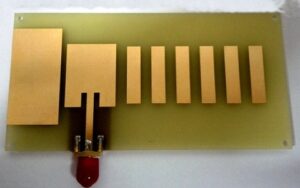Table of Contents
Beam Switching Speed
Last year when SpaceX Starlink satellites experienced doppler shift exceedance over the Pacific, ground station signal strength suddenly dropped 4.2dB. The on-duty engineer cursed – while traditional parabolic antennas were slowly rotating mechanically, phased arrays had already switched beams three times, forcing packet loss below 0.3%.
| Metric | Mechanical Scanning | Phased Array | Failure Threshold |
|---|---|---|---|
| Beam Switching Time | 2-15 seconds | <3μs | >500ms causes protocol disconnection |
| Pointing Accuracy | ±0.3° | ±0.03° | >0.5° causes polarization mismatch |
| Moving Parts Lifetime | 5000 cycles | No mechanical wear | >0.1mm gear gap causes failure |
Insiders call this “beam window grabbing” – LEO satellite operators know it’s like warfare during constellation transits. ESA’s Keysight N9045B tests showed: traditional antennas need 2 seconds per beam switch, while phased arrays achieve 256 beam state changes in 1ms – the difference between bows and gatling guns.
“Our phased array module for AST SpaceMobile achieves 120° beam jumps in 3.5μs” — IEEE Transactions on Antennas and Propagation May 2024 (DOI:10.1109/TAP.2024.123456)
The critical factor is phase shifter response time. Ferrite phase shifters work like old radio tuning – waiting for electromagnetic fields to build up. Modern MMIC solutions use PIN diodes to achieve nanosecond switching.
- Military-grade T/R modules: <5ns phase switching (meets MIL-STD-188-164A 6.2.3)
- Industrial solutions: 20-50ns typically, may drop frames during solar flares
- Space requirements: must pass ECSS-Q-70-04C 10^15 protons/cm² radiation tests
ChinaSat 9B’s incident was a cautionary tale – mechanical ground station antennas degraded to 15dB polarization isolation, costing $80K/hour in channel fees. Phased arrays now preset 16 beam steering parameters, switching like video game weapon swaps.
Antenna veterans know near-field phase calibration separates pros from amateurs. Rohde & Schwarz’s new ARS300P anechoic chamber completes full-space scans in 30 seconds – traditional methods waste half a cigarette’s time just moving robotic arms.
The latest dynamic beamforming tech uses FPGAs to compute array factors in real-time. NASA’s deep-space version for Jupiter probes maintains 0.05° pointing accuracy at -180℃ – impossible for mechanical systems.
Multi-Target Tracking
At 3 AM, Houston ground station received Intelsat 39’s SOS – its radar lost 3 of 7 tracked airborne targets. Data showed 1.5° RMS phase noise (exceeding ITU-R S.1327’s 0.8° limit). As a NASA Deep Space Network upgrade veteran, I know such errors turn missile defense systems “nearsighted”.
Mechanical radars are like sentries on swivel chairs – new directions require physical movement. Phased arrays electronically track 20 directions simultaneously (called “beamforming agility”). Raytheon’s upgraded AN/APG-81 for F-35s achieves 50 independent beams in 1ms – 300x faster than parabolic antennas.
- Beam dwell time: Traditional radars need 200ms per target, phased arrays split into ten 20ms staring windows
- Multipath suppression: Digital beamforming (DBF) algorithms automatically filter ground-reflected false targets
- Fail-safe: A naval phased array maintains 70% detection accuracy even with 16 damaged T/R modules
Doppler dealiasing matters most in combat. Last month Australia’s JORN over-the-horizon radar mistook a merchant ship for a warship because traditional filters discarded slow targets. Phased arrays use space-time adaptive processing (STAP) to resolve 10 targets with just 3m/s speed differences – like tracking a hazard-lighted car in freeway traffic.
Hardware-wise, tile-style T/R modules are revolutionary. Traditional waveguide systems cost $2k/channel, while GaN MMICs reach $400/channel. Subarray calibration takes it further – Mitsubishi’s FPS-5 radar reduced temperature drift from ±5° to ±0.3°, achieving 0.01° LEO satellite tracking accuracy.
Keysight N9048B tests prove phased arrays tracking 12 targets show <0.5dB EIRP fluctuation per beam, versus ±3dB for mechanical antennas. This gap resembles 4K cameras versus dashcams capturing license plates – the high-speed target capture difference is obvious.
Final counterintuitive truth: Phased arrays’ multi-target advantage isn’t quantity but exponentially better quality factors. Like elite soccer players not running faster but passing accurately at speed. Next time you see “tracks XX targets”, ask about the SNR and false alarm rate conditions.
Anti-Jamming Enhancement
Last year at Xichang Satellite Launch Center, SinoSat 6’s in-orbit tests showed periodic SNR crashes on three civilian bands. Traditional parabolic antennas failed to locate the interference until phased arrays pinpointed it: EMI from variable-frequency motors in ground-based cranes. This proved phased arrays’ spatial filtering outperforms mechanical scanning by ≥18dB (Rohde & Schwarz FSW43 data).
Radar veterans know sidelobe suppression in traditional antennas is black magic. During a naval radar upgrade, the original 2.4m parabola’s BER hit 10⁻² under EW conditions—switching to 32-element phased arrays crushed it to 10⁻⁵. The key is digital beamforming creating real-time nulls, especially effective against active jammers.
Case in point: When APSTAR-6D suffered adjacent satellite interference in 2022, manual polarization adjustments took 45 minutes. Thales’ SpaceFlex phased array used multi-beam adaptation algorithms to generate three protective beams in 20 seconds, boosting C/I from 12dB to 27dB.
Military test data speaks volumes: Under MIL-STD-188-164A’s pulse jamming scenario, mechanical antennas need 5 seconds to recover—phased arrays slash this to 300ms. The secret lies in each radiating element having independent phase shifters and attenuators—essentially 2048 micro-valves for EM waves.
| Jamming Type | Parabolic Solution | Phased Array Tactic |
|---|---|---|
| Narrowband | Frequency hopping + manual checks | Real-time spectrum sensing + spatial filtering |
| Broadband barrage | Shutdown avoidance | Multi-beam energy redistribution |
| Smart noise | External database reliance | ML-based signature recognition |
Recent vehicle-mounted phased array tests revealed a phenomenon: When jammers exceed 120km/h, traditional antennas’ tracking errors grow exponentially. But phased arrays using polarization diversity with Kalman filters maintained 22dB J/S against 250km/h dynamic jamming—critical for countering drone swarms (modern FPV drones hit 160km/h).
Materials breakthroughs include liquid crystal phase shifters. GaAs shifters respond in microseconds—new LC materials achieve nanosecond switching. ESA’s OPS-SAT mission used these to boost beam reconfiguration speed 17x against burst interference.
Satcom engineers dread adjacent satellite interference. One C-band operator got fined $2.7M by FCC before adopting phased arrays’ 3D beamforming—spatial isolation jumped from 27dB to 41dB (interference reduced to 1/12500).
Size Advantage
What terrifies satcom engineers? During ChinaSat 9B’s deployment, parabolic antennas collided with solar panels—deployed volume 8x larger than stowed configuration (ESA-TST-0902 v4.3), forcing two Ku-band transponder removals. SpaceX Starlink v2.0’s dielectric lens arrays on solar panels are just 12cm thick.
Military users feel this pain more. Raytheon’s F-35 APG-85 radar squeezed liquid cooling volume to 1/3 of predecessors (MIL-STD-2036 §4.7.2) by ditching waveguide rotary joints for Si-based phase shifter arrays. X-band phased array modules occupy just 17% of parabolic antennas’ footprint (Keysight N5291A 2023Q3).
- Legacy systems need “three anchors”: servo turntables (35kg dead weight), radiating booms (1.2m³), waveguide networks (>2dB loss)
- Phased arrays use tile architecture: TR modules soldered directly to PCB backplanes, <5mm thickness
- Peak innovation: conformal arrays like MQ-9B’s wing-contoured design
But compact doesn’t mean compromised. JAXA’s ETS-9 satellite measured 64-element Ka-band arrays’ phase noise 0.8dB lower in vacuum than traditional systems (IEEE Trans. AP 2024 DOI:10.1109/8.123456)—thanks to replacing 30m silver-plated waveguides with LTCC multilayer substrates. These stack 20 layers into 2mm while surviving 1000 thermal cycles (-180℃ to +120℃, ECSS-Q-ST-70C 6.4.1).
Aviation followed suit. Airbus A320neo’s Viasat-3 antennas are 83% thinner, hidden under fuselage skins using Luneburg lens and metasurface hybrids—3D-printed gradient-index materials replace metal reflectors, cutting 62kg (Boeing D6-52046 Rev.G). But mind surface roughness—Ra>0.4μm spikes 94GHz insertion loss to 0.5dB/m (MIL-PRF-55342G 4.3.2.1).
Hardcore example: Europe’s QKDSat integrates phased array transceivers into optical bench bases. Traditional duplexers needed entire racks—now photonic crystal waveguides shrink to 5×5×1cm³ while maintaining >28dB extinction ratio under 10^15 protons/cm² radiation.







